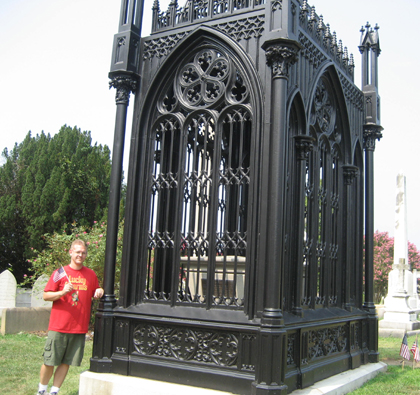 Our fifth American President James Monroe served the country from 1817 to 1825. A good friend and student of Thomas Jefferson, Monroe had also served as Secretary of War and Secretary of State during the War of 1812. He is the author of the famous Monroe Doctrine, in which he forbid European powers from interfering with the affairs of the United States. My association with President Monroe was confined to the week I spent touring Virginia with my friend Bob. Here we saw several historical sites from the life of James Monroe.
Our fifth American President James Monroe served the country from 1817 to 1825. A good friend and student of Thomas Jefferson, Monroe had also served as Secretary of War and Secretary of State during the War of 1812. He is the author of the famous Monroe Doctrine, in which he forbid European powers from interfering with the affairs of the United States. My association with President Monroe was confined to the week I spent touring Virginia with my friend Bob. Here we saw several historical sites from the life of James Monroe.
Sunday, August 5, 2007 – James Monroe Birthplace – As Bob and I were heading from our motel in Colonial Beach to Washington’s birthplace in Pope’s Creek, Bob spotted a sign out of the corner of his eye that appeared to say “Birthplace of Monroe.” We did a u-turn in the car for more careful observation. And thus, our ‘accidental’ visit to the birthplace of James Monroe occurred. We didn’t realize that we were standing in the heart of Westmoreland County. This inspired us immediately to determine the other sites of the Virginia-born Presidents.

The ‘accidental’ finding

Monument located on the grounds of the property where Monroe was born

Me and the monument amidst the landscaping going on
Sunday, August 5, 2007 – James Monroe Museum and Memorial Library / Former law office of James Monroe – Before he assumed the Presidency, James Monroe studied law under Thomas Jefferson. From 1786 – 1790 he practiced law in Fredericksburg (and also lived nearby in a home that is now privately owned). Where these offices once stood now resides the James Monroe Museum and Memorial Library.
Quite small and intimate relative to other official Presidential Libraries, the Monroe Museum displays many Monroe-owned artifacts and exhibits. Among them furniture from various periods of the Monroe family, a bust of Monroe presented to him by Lafayette, original paintings, Monroe’s dueling pistols, and most impressively, the desk on which he wrote the Monroe Doctrine. Also discovered in this desk where correspondence that Monroe neglected to destroy (as he had with much of his other papers) between himself and Washington and Jefferson. This museum was certainly worthwhile.

At the Monroe museum

Indicating that the museum was once James Monroe’s law office

Outside the museum, me and a bust of Monroe (I’m on the left)
Thursday, August 9, 2007 – James Monroe’s Highland home – At Thomas Jefferson’s suggestion, James Monroe purchased a 1000-acre plot of land adjacent to Jefferson’s Monticello estate in 1793. by 1799 the Monroe family had settled in the home and it remained in his possession for 26 years. Following the Monroe Presidency, he was forced to sell the home in 1825 due to impending debt.
The Charlottesville house changed hands several times over the next forty years, with one of the owners re-christening Highland as Ash Lawn. In 1867 the property was sold to the Massey family with whom it remained in the possession until 1930. The Massey’s added an addition to the house, informally known as the ‘yellow building.’ The house was sold for the last time to philanthropist Jay Winston Johns, who allowed the public to tour the house as a historical location. He bequeathed the house to James Monroe’s alma mater The College of William and Mary, who continue to own and operate the house as a historical landmark.
Bob and I had an outstanding tour of this house with the most informative and well-versed docent I have ever seen. We toured the entire ‘yellow’ edition as well as the orginal Highland portion, both inside and out.
President Monroe also spent nine years of his post-Presidency living on “Monroe Hill” at the University of Virginia (see the posting on Thomas Jefferson). One additional home was formally located in the Charlottesville area but we were unable to find information as to if (or where) it was still standing.

At the entrance to Ash Lawn – Highland

The back of Highland with the additional ‘yellow building’

The front door of the original Highland

Charlottesville sign indicating three of the local homes of President Monroe
Monday, August 6, 2007 – James Monroe’s Grave – James Monroe became the third President to die on the Fourth of July. His passing occurred in 1831, five years to the day after the deaths of John Adams and Thomas Jefferson. Monroe was initially laid to rest in New York where he remained for 27 years at which time he was re-interred at the Hollywood Cemetery in Richmond, Virginia in what is now known as the Presidential Circle. Monroe is buried just yards away from President John Tyler. His crypt lies inside a gated iron enclosure.

Plaque on the Monroe crypt

Grave marker of the First Lady

Me and James Monroe
Continue to the next President…
Return to Sunday in Virginia…
Return to Monday in Virginia…
Return to Thursday in Virginia…
Leave a Reply